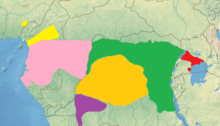Johnston Mangabe
| Johnston Mangabe | ||||||||||||
|---|---|---|---|---|---|---|---|---|---|---|---|---|
| Systematics | ||||||||||||
|
||||||||||||
| Scientific name | ||||||||||||
| Lophocebus johnstoni | ||||||||||||
| ( Lydekker , 1900) |
The Johnston mangabe ( Lophocebus johnstoni ) is a species of primate from the family of the vervet monkeys (Cercopithecidae). For a long time it was considered a subspecies of the gray-cheeked indication , but was raised to species status in 2007.
Johnston Mangabies are slender primates with long limbs and a long tail. Their fur is consistently dark, mostly black-brown, colored and not lighter on the underside. The head is characterized by the elongated snout, the long cheek hairs are colored gray-brown. At the top of the head they have two horn-like heads of hair. The color of the long hair on the shoulders varies from dark brown to gray-brown.
Johnston mangabians live in central Africa. Its distribution area includes the north and east of the Democratic Republic of the Congo - here the Congo River forms the southern border - as well as Rwanda and Burundi . Their habitat are forests, predominantly tropical rainforests .
Little is known about the way of life of the Johnston Mangaben. Presumably, like all black information, they are diurnal tree-dwellers who rarely come to the ground. They live in small groups and feed on fruits, nuts and small animals.
Little is known about the degree of risk. The IUCN does not yet list the species separately from the gray cheek indication.
literature
- Thomas Geissmann : Comparative Primatology. Springer-Verlag, Berlin et al. 2003, ISBN 3-540-43645-6 .
- Colin Groves : The Endemic Uganda Mangabey (Lophocebus ugandae), and Other Members of the albigena-Group (Lophocebus). In: Primate Conservation. No. 22, 2007, pp. 123-128, doi : 10.1896 / 052.022.0112 .
